Purpose
This project is testing the effects of AgTiv Mycorrhizal Inoculant on potato and cereal crops. The inoculant is said to improve plant growth and health, increasing overall yields and quality of the crop. With the added fungi in the soil, the mycorrhizal inoculant also improves soil health and structure. This trial is testing the effectiveness of the inoculant on improving crop production and soil health. If successful in doing so, the inoculant could improve the quality and yields of crops grown in Northern Ontario, therefore benefiting farmers with increased profits from these crops. Long-term benefits would also be provided from improved soil quality, resulting in higher-quality crops in the future.
Background
Mycorrhizal fungi are naturally found in soils but farming and soil disturbance leads to a drastic decrease in the fungi population, therefore reducing the benefits from the symbiotic relationship that mycorrhizae form with plant roots. This relationship helps to stimulate plant growth and accelerates root development, producing more vigorous and healthy plants. The fungi can absorb nutrients and water from the soil that would otherwise be unavailable to the crops, transferring these resources to the plant roots, which increases plant access to nutrients and water. This positive interaction can increase plant growth and production. The mycorrhizae also help improve soil structure, increase organic matter, and play a positive role in soil aggregation.
These mycorrhizal inoculants have been shown to have many benefits on plant production, by stimulating more vigorous growth, producing healthier, disease-resistant plants and increasing yields. The species in the inoculant promote increased water uptake, potentially producing more drought tolerant plants. The mycorrhizae also help to optimize fertilizer use of the plants by improving nutrient uptake and can possibly reduce susceptibility of soil to erosion by improving soil structure.
Many trials done on the use of mycorrhizae inoculants on different crops have shown improvements in plant health and yields. Therefore, there is a strong possibility that this product would be a viable option for improving crop production in Northern Ontario.
Methods
Four farms in the Sudbury and Nipissing regions were selected, including two potato growers and two cereal growers. Each farm has two 5-acre sites selected: one being high fertility and one being low fertility, based on the farmer’s knowledge of their fields. Each 5-acre plot has side-by-side strips of mycorrhizal inoculant and control. (see Figure 1).
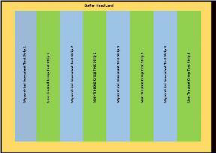
Figure 1. Plot Layout
AGTIV POTATO Liquid product was used on the potato plots, and either AGTIV FIELD CROPS Powder or Liquid was used for the cereal crops. The inoculant will either be mixed with the seed at planting or applied in-furrow with a starter or pesticide application, depending on the farmer’s equipment and which product they were using.

Figure 2. Sirrus app used for plot mapping and soil sample records.
Soil samples were taken before the first planting and then taken annually in the fall to evaluate soil fertility changes. Fields were mapped out and soil samples tracked using the app “Sirrus” (See figure 2). Soil samples are being sent to A & L Labs for the VitTellus℠ Soil Health Test (see Figure 3). Lab results are being interpreted and formatted into field maps by Ben Schapelhouman, CCA-ON from TECC Agriculture Ltd (see Figure 4).
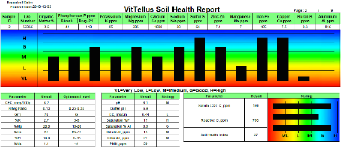
Figure 3. VitTellus℠ Soil Health Test
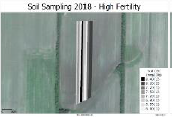
Figure 4. Soil sample map and analysis results combined by Ben Schapelhouman (TECC Agriculture).
It was planned to take plant tissue samples throughout the growing season but due to timing and lack of labour these samples were not obtained. Regular measurements of plant growth and development were taken throughout the season to compare plant development between the treated plants and the controls. Yield measurements were taken at harvest and crop quality testing was done to measure the overall impact of the mycorrhizal inoculant. To accommodate for crop rotations, soil samples were taken from each replication in years when potato crops are not grown. The trial is being conducted for three years, from 2018-2020.
Results
Oats:
The oat plot seemed to perform well this year, given the weather. The oats were planted into soil with medium to low phosphorus and potassium but with a good soil pH. A site visit on July 9, 2019 showed slightly more root development in the oats treated with the inoculant (see figure 5). The plot was harvested on August 23, 2019. A weigh wagon was used to measure yield from each strip and measured in bushels per acre (see figure 6 and table 1). Results shows ~1.5% greater yield for oats treated with mycorrhizal inoculant than without. Looking at this from an economics perspective, given market prices, this could produce up to $10/acre greater revenue.
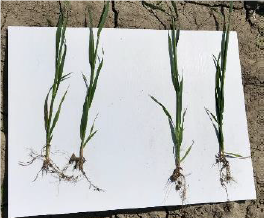
Figure 5. July 9, 2019 – root comparison of inoculated oats (right) versus non-inoculated roots (left).
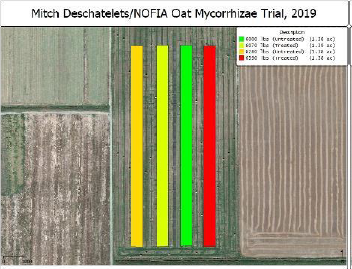
Figure 6. 2019 oat results.
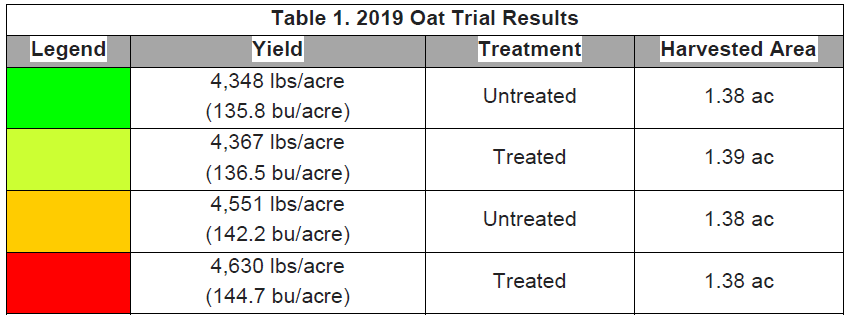 Soybeans:
Soybeans:
There were three plots of soybeans this year: two planted into lower fertility ground (based on what the farmer knew of their fields) and one into higher fertility ground. The low fertility plots had lower phosphorus and potassium. The higher fertility plot had higher potassium and more organic matter. Results from these plots showed a more apparent difference in treated vs. untreated in the lower fertility plots compared to the higher fertility plots. A site visit on July 9, 2019 showed slightly more root development in the soybeans treated with the inoculant (see figure 7).
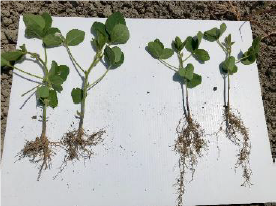
Figure 7. July 9, 2019 – root comparison of inoculated soybeans (right) versus non-inoculated roots (left).
The general findings showed ~2 bu/acre increase in yield for soybeans treated with the mycorrhizal inoculant, or $22.38/acre greater revenue (see figure 8 and table 2).
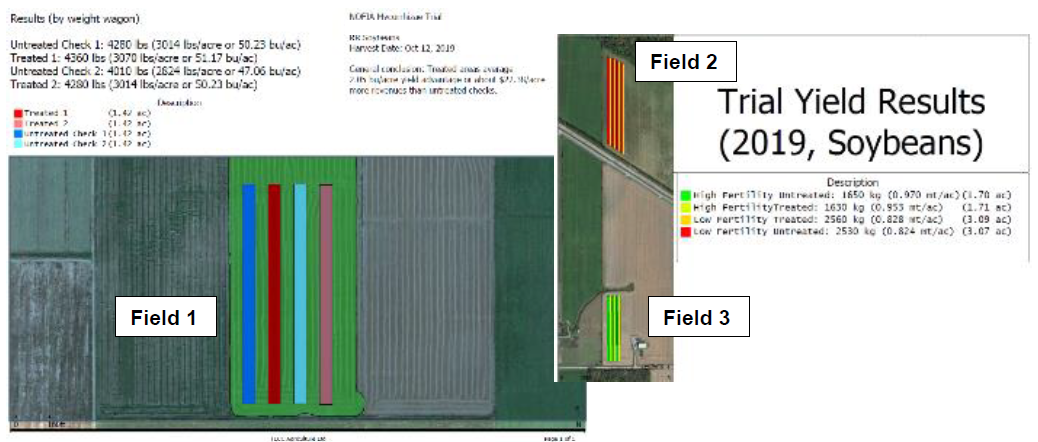
Figure 8. 2019 soybean results.
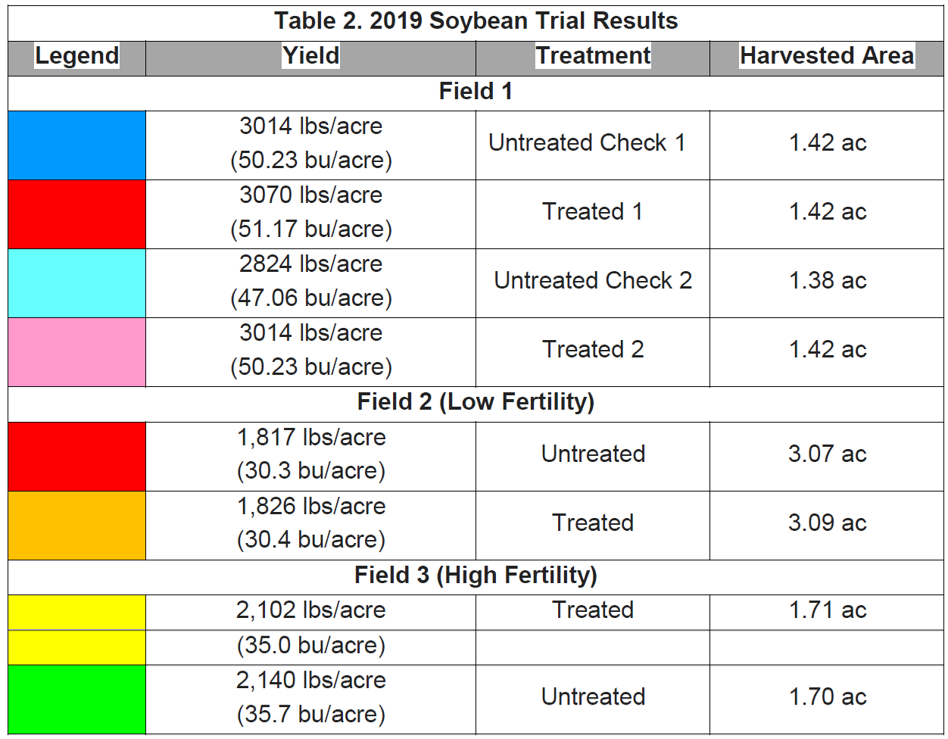
Potatoes:
With the very wet spring of 2019, potatoes were late being planted. Despite this, three plots were planted (two low fertility, one high). A site visit on July 9, 2019 showed more root and above-ground vegetative development in the potatoes treated with the inoculant (see figures 9 & 10). Unfortunately, due to equipment difficulties at harvest, we were unable to get accurate harvest data. However, anecdotal harvest observations allowed us to estimate an approximate 15% greater yield for inoculated potatoes versus uninoculated. Comparing this to results from previous studies (Hijri, 2016; Douds Jr., 2007) gives us confidence in this estimate, however results from year 3 will allow us to confirm the accuracy of this estimate.
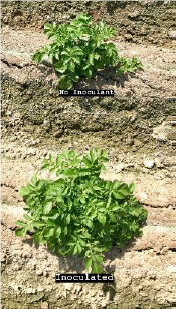
Figure 9. July 9, 2019 – above-ground vegetation development comparison of inoculated potatoes (bottom) versus non-inoculated roots (top).
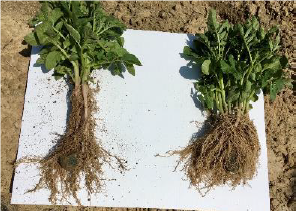
Figure 10. July 9, 2019 – root development comparison of inoculated potatoes (right) versus non-inoculated roots (left).
2019 Summary & Next Steps
Overall, use of the inoculant seems to be producing positive results, with slight increases in yields seen in every crop. A greater difference was seen in soils with lower fertility, which was expected. In 2020 we expect to examine effects on plant health and harvest quality further, as well as the impact of the inoculant in the soil from the previous year.
We are also working closely with Collège Boréal to leverage funding for an NSERC project to increase agricultural research in Northern Ontario. They are supporting us through groundwork at the plot sites for this project by assisting with sampling.
References:
Hijri, M. 2016. Analysis of a large dataset of mycorrhiza inoculation field trials on potato shows highly significant increases in yield. Mycorrhiza 26, 209–214 (2016).
https://doi.org/10.1007/s00572-015-0661-4
Douds Jr., D.D., Nagahashi, G., Reider, C., and Hepperly, P.R. 2007. Inoculation with Arbuscular Mycorrhizal Fungi Increases the Yield of Potatoes in a High P Soil, Biological Agriculture & Horticulture, 25:1, 67-78, DOI: 10.1080/01448765.2007.10823209
Acknowledgements
A huge thank you to our farm co-operators, Valley Growers for their industry expertise, Collège Boréal for their project support, TECC Agriculture for their agronomical support, Northeastern Ontario Soil and Crop Improvement Association and the local associations for their project and communications support, and the Northern Ontario Farm Innovation Alliance for collaborating the project.
Project Contacts:
Emily Potter, Executive Director, NOFIA, emily.nofia@gmail.com
Alex McRae, President, Northeastern Ontario SCIA, gawasfarm@gmail.com
